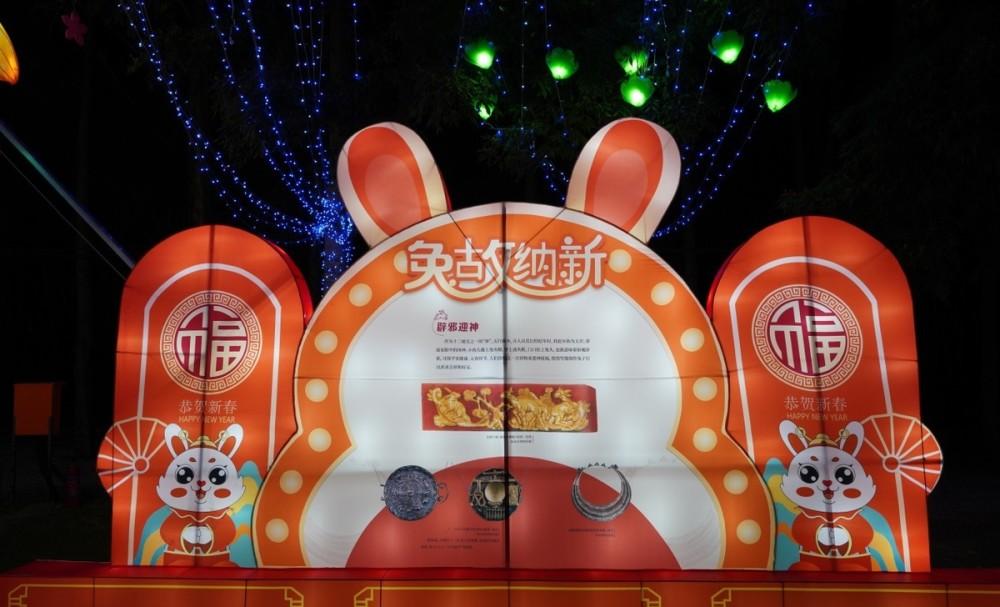Guided by the State Administration of Cultural Heritage and jointly sponsored by the Chengdu Jinsha Site Museum and China Cultural Heritage Newspaper, the "Da Zhanhong 'Rabbit' - Chinese New Year Zodiac Cultural Exhibition" is currently on display. From the three parts of rabbit in natural ecology, rabbit in historical culture and rabbit in folk culture, the exhibition systematically shows the audience the origin of zodiac culture and the profound connotation of rabbits in traditional Chinese culture.
According to reports, this exhibition not only unites more than 50 cultural institutions across the country, selects hundreds of cultural relics related to rabbit culture in different periods and regions for display, but also combines the zodiac culture exhibition with intangible cultural heritage lanterns for the first time, and changes the graphic layout into three-dimensional lanterns in different rabbit shapes in the exhibition design, which complements the light and shadow atmosphere of the "2023 Chengdu Sands Sun Festival" being held in the museum.

Expand the "rabbit" and see the cultural history of the rabbit for thousands of years
The mainland is one of the first countries in the world to domesticate rabbits, and Yin Wu has unearthed the skull, upper and lower jaws and limb bones of shang dynasty hares, proving that hares have entered the life of Chinese at that time. For thousands of years, rabbits, as the messengers of auspicious rui from heaven, have played an important role in the classics, poetry works and various cultural relics of the past. The rabbit is docile and gentle, and when combined with jade, which also represents purity, it gives birth to all kinds of jade rabbits, symbolizing wealth and virtue; Because of his agility when jumping, successive generations of literati have coined the idiom "moving like a rabbit", which is a metaphor for people's agility; And its well-behaved and cute image is often integrated into all kinds of exquisite viewing objects, presenting the social life and historical style of the time. In addition, out of love and worship of the rabbit, people also included it in the Chinese zodiac, and the zodiac rabbit has become a link that maintains the feelings and culture of the Chinese nation.
Green jade inlaid gemstone crouching rabbit, Qing Dynasty, Palace Museum collection Blue and white rabbit pattern flower mouth plate Ming Dynasty Palace Museum collection
Shu rabbit Chengxiang, Sichuanese people not only love to eat rabbits
There is always a joke that "no rabbit can leave Sichuan alive", which is an excellent proof that Sichuanese people love to eat rabbits. In addition to being loved by the Sichuan people as food, rabbits, as auspicious beasts and symbols of health and longevity, were worshipped by the ancestors of Sichuan as early as the Shang and Zhou Dynasties, and their images were widely used to decorate sacred objects and living utensils.
Therefore, the exhibition specially set up the "Shu Rabbit Chengxiang" section to comprehensively present the rabbit image in Shu culture, whether it is the portrait brick of the Western Queen Mother, the first treasure of the former Shu King Jianrabbit, or the Honghuangtu cash cow stone seat, etc., from these exquisite high-definition cultural relics pictures, the audience can get a glimpse of the Chongtu culture in Sichuan.
Portrait brick of the Western Queen Mother, Eastern Han Dynasty, Sichuan Museum collection
In addition, rabbits are also indispensable in folklore and allusions. Sometimes it becomes the pet in Chang'e's arms when she runs to the moon, and sometimes it becomes the medicine god "Rabbit Grandpa" who cures diseases and disasters. Children can wear rabbit hats and carry rabbit lamps to seek peace and health.
In addition to the dizzying rabbits on the page, Jinsha has also specially created an interactive area of "Guessing Lantern Riddles in the Year of the Rabbit" and "Idiomatic Rabbit", attracting the enthusiastic participation of citizens who start their rabbit hunting journey at the Jinsha Site Museum. (Photo by Tao Xiaoli)
(China Daily Sichuan Reporter Station Huang Zhiling)